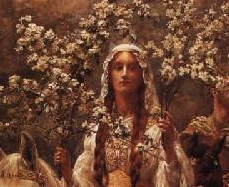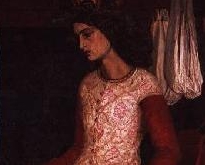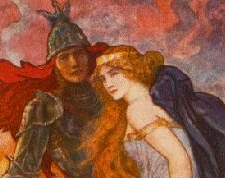![]()



The Characterization of Guinevere by the Victorians (i.e. Tennyson, Morris, Swinburne) and How It Relates to the "Woman Question" (A Feminist Approach)
"Guinevere" from Idylls of the King by Alfred, Lord Tennyson"The Defence of Guinevere" by William Morris
"The Day Before the Trial" by Algernon Charles Swinburne
I. Introduction and Recap of Seminar Thesis
II. What is the Woman Question?
A. Significance of Name
B. VERY SHORT History and BackgroundIV. "Guinevere" from Idylls of the King by Alfred, Lord Tennyson
<<read the poem>>A. Brief Background on Author, Role as Poet Laureate
B. Criticism of Work
C. Opinion of the Victorian Woman, GuinevereV. "The Defence of Guinevere" by William Morris
<<read the poem>>A. The Oxford Mural Project, Arthurian Iconography
1. "Guinevere" (or "La Belle Iseult") by William Morris
2. "Guinevere A-Maying" by John CollierB. The Pre-Raphaelites and their Women
VI. "The Day Before the Trial" by Algernon Charles Swinburne
<<read the poem>>A. Introduction to A.C. Swinburne, Pre-Raphaelite Influence
B. The Voice of the King
- Victorian issue which dealt with the role and status of women in society.
- "For on trial during the Victorian period was not only the institution of marriage, but the family itself, and most particularly, the traditional roles of women as wives, mothers and daughters." (Norton, 1595)
- Poem "The Angel in the House" by Coventry Patmore = established what became the DEFINITIVE image of the Victorian woman
- Good Girls Make Good Wives: Guidance for Girls in Victorian Fiction by Judith Rowbotham
- A woman's options were limited to three career choices: wife/mother, spinster/governess, nun.
Significance of the Name
- Welsh: Gwenhwyfar, meaning "white ghost"
- In Welsh tradition, the name carried with it such shame that it was regarded as an insult to a girl's moral character to call her Guinevere.
Short History and Background
- born of a rich father, King Leodegrance, whose family had strong Roman allegiance and who followed Roman traditions. As a young woman, married to Arthur, either for love or for political loyalties. Became Queen of the Kingdom, had no children. Upon meeting Lancelot, who as the best knight proved to be worthy to be her champion, she falls in love with him and has an affair with him. Arthur finds out, condemns her to die or exiles her off.
Brief background:
- Poet laureate under Queen Victoria: role as poet laureate is to comment on issues, problems currently afflicting society
- Well-renowed for his lyrical poetry, mainly In Memoriam, and Idylls of the King
- Studied in Cambridge, became involved in the "Apostles"
- Appearance: huge, shaggy, in cloak and broad-brimmed hat, gruff in manner
- "Two Arthurs" --> "For much of his life Tennyson was absorbed with two Arthurs. One was King Arthur; the other was Arthur Henry Hallam, the poet's closest friend, who died in 1833 at age 22, and who was the subject of Tennyson's In Memoriam. Clearly the two Arthurs were never entirely separate in Tennyson's mind or in his poetry. His grief for his friend surely contributed to the intensity of his Arthurian vision, while King Arthur remained to an extent a metaphor that helped to immemorialize Hallam." (Lacy & Ashe)
ROLE AS POET LAUREATE: Social Significance of Poetry, and the Return to the Past
- "The Idylls provides Tennyson's most extensive social vision, one whose concern with medieval ideals of social community, heroism, and courtly love and whose despairing sense of the cycles of historical change typifies much of the social thought of the age." (Norton, 1054)
- idealized the past as being better, as being as close to the version of perfection
- "Tennyson was drawn to the past in an attempt to illuminate and perhaps to repudiate the present; much of his poetry represents a reaction against the prevailing mechanistic view of nature and the ugliness of an increasingly industrialized society. His concern was much less with medieval ideals than with the Victorian moral condition, and the best mirror for that condition was ing Arthur, known to the poet through Malory and other sources." (Lacy & Ashe)
- "If the Idylls have a serious flaw, it is for some readers Tennyson's failure to offer a positive alternative to the materialism he was rejecting. Although he looked to the past as a remedy for present ills, the promise of Camelot proved to be an illusion or at best a brief respite from the darkness and savagery that preceded it and into which the world quickly sank again upon Arthur's passing. Yet Tennyson does not replace that failed promise by another. Readers may be in fact be distracted by his very attempt to use the past as little more than a mirror for the excesses and evils of his own day." (Lacy & Ashe)
Criticism of Work
- flowery, pretty, according to Carlyle: mere "lollipops" (Norton)
Idylls of the King; in-depth
- [the] poem "Guinevere," presents the Queen as a complex individual torn between her ideals and duty on the one hand and her passion on the other..."Elaine" [which follows] illustrates the destructive effect Guinevere's adultery works on others. (Lacy & Ashe)
- TONE: not happy or optimistic...melancholy, sense of foreboding
- In Malory, Gwen is shown to act as feminist: a woman who knows what she wants and doesn't care what other people think of her or what society expects from her
"From the beginnings of Malory, Guinevere is introduced as something other than a model woman, and because she is not an archetype, or an imitator of archetypes, her introduction barely suffices to describe her or the career she will follow...Rather than allowing the institutions and rituals of her society to define her, Guinevere struggles to define them. Hers is not a life of doing what is right, what is pleasing to those in authority, those who formulate the ritualistic pattterns for women to follow, but rather one of attempted self-realization.Guinevere is manipulating rather than manipulated. She exerts authority to her own ends. Instead of ministering to men, they minister to her....But like all who function in historical time, Guinevere pays a price. She is not comforted by eternal returns; there is constant uncertainty in her life." (from Martin Shichtman, "Elaine and Guinevere: Gender and Consciousness in the Middle Ages")
However, Tennyson changes THAT image of Guinevere into his expectations of what a good Victorian Queen, a good Victorian woman should be. She might have started that way, but she realizes her mistake and repents
- Mary Etta Scott has outlined three categories into which most of Malory's women fall: the Good, the Bad, and the Ugly....[explain this a little bit] (from "The Good, The Bad and the Ugly: A Study of Malory's Women")
Scotts' second category, the Bad, is the most interesting because it contains the central female character, Guinevere. The Bad, according to Scott, are "the ordinary women men deal with every day when they are not on a holy quest."
These are the women, Guinevere being the most fully developed among them, whose character reveal how the objectification of women and their subsequent status as rewards for success in battle leads to unification of males in a power structure (here the Round Table) for a limited time, but ultimately results in a destruction of that power through rivalry. Each of these women finds herself bound to a male character because he has "won" her by force or finds herself divided in loyalty between a husband who has attained her by social force and a lover who has won her by physical prowess.
Scott's Bad Women, whose characters she dismisseds as another example of Malory's culturally unavoidable male chauvinism, are really the constrained women, those who adhere to the values of the court and find themselves caught up in its contradictions.
--> SUMMARY of QUOTE: the Bad women are called such because they have to deal with real problems of the real world, e.g. dealing with relationships and divided loyalties: heart vs. head, emotions vs. practicality -- the same exact issues Gwen was dealing with. They are not one-dimensional puppets, they are REAL, they are TRUE.
Something that Victorian women must deal with: should they follow their heart or their head, work or home, family or career, society vs. self, tradition vs individuality...etc, etc, etc.
What kind of woman does Tennyson want Gwen to be? He wants her to be penitent, sorrowful, grieving over what she has done, which is in essence, destroying the kingdom. Parallel with the women of England, warning them that the changes which he is seeing in the society is creating the same amount of damage that Guinevere created in her sin, and they should stop before they destroy the kingdom as well.
Advocates the values of self-postponement: "the quiet, the reserve, the lack of incident, and the self-sacrifice of her existence...submission to father and brothers (or husband or lover), and to her religion" --> deferment of love, of the self, personal deference or subordination (Blake)
Since Guinevere did not fulfill the role of wife/mother well, the only option that she had left was to be a nun
The Oxford Mural Project
- "In 1857, DG Rossetti was asked by the Oxford Union Committee to design a program of ten mural in the Debating Hall of the new Union Building. Incl. Edward Burne-Jones, Arthur Hughes, Morris, et al...Ten scenes from Malory...Technically, the murals were a disaster. The excessive illumination made viewing impossible, and by 1870 they had deteriorated on the walls, which had not been treated." (Lacy & Ashe, Encyclopedia)
WHY IS THIS IMPORTANT:
- Introduced Morris to the beautiful love that is Arthurian subjects
- Link of the Pre-Raphaelites with Arthuriana
- Preference of Malory over Tennyson
- Relationship of Rossetti & MorrisArthurian Iconography
* Guinevere or La Belle Iseult by William Morris
- only oil painting ever completed by Wm. Morris
- significance of symbols: woman dressing, dog on the bed, uncombed hair, sheets, height & stature
- modeled on wife Jane Burden* Guinevere A-Maying by John Collier
- describes Gwen's arrival into Camelot
- pastoral, springtime, goddess, renewal
- purity; marked contrast with Wm. Morris' paintingSUMMARY AND CLOSE-READING OF POEM
- "The ambiguities within the poem are deliberate; they stem from Gwen's character, not Morris' uncertainty about it. The queen does not know whether she is morally guilty; she is uncertain about the rightness of her position, certain only of the strength of the love that has placed her in it. She can defend her love, indeed, she will not deny its worth or power, but she cannot always defend the adultery that it has caused, thus she attempts at times to deny the latter and always to minimize its importance. She hints at her her actions, half confessing through double-meaning statements, slipping through the imagery she uses, into temporarily admitting adultery, then withdrawing into a stance of innocence and ostensibly retracting the statements she has made. Denying, finding excuses, equivocating, she always stops short of full confession. The keynote of the poem -- and of Guinevere's character -- is the poem's first word, "But."
On one level she is sarcastically flattering her audience, saying that the lords in their wisdom and rank are not to be contradicted...
Test of the cloths: choice of color being wrong, chose hell instead
...Is ostensibly pleading that the wrong choice in her life was made unwittingly, but she is also suggesting that the choice was logical and the one all would have made. Her argumentative skill almost makes the reader forget that she is confessing; in saying that she had chosen hell, she means not only unhappy love, but adultery...But she still will not admit that, whatever the cause, she has not done wrong.
The queen reveals herself even more directly when her speech works against its intentions, when she slips into saying too much. She says more when she intends when she pleads for kindness from Gawain, asking him to "Remember what grave your mother sleeps." --> associates herself with guilty mother Morgawse who did commit adultery; guilty by association
Ironically, her self-vindication backfires, in pleading "temporary insanity," she convinces the reader that she has done what she will not quite openly admit. One of the strengths of the poem is that her central argument -- moral confusion -- is what convinces the reader she is an adultress. The reader is to appreciate her consummate rhetoric, her methods of handling her judges -- she seduces, cajoles, threatens them -- and by the variety of pleas by which she seeks to win sympathy and time...For example, what she says she will not say and what she does say are quite different. She states that she will not review the past, but her purpose is just to do that, slanting events to win her audience's sympathy...
STYLE of poem: closest to Robert Browning, dramatic monologue
The Pre-Raphaelites and Their Women
-"In Guinevere he now found both the pre-Raphaelite image of beauty and the romantic concept of the fatal woman, loved and desired by all -- but doomed to destroy herself and those who adore her."
- BEAUTY; appeals that her beauty is "gracious proof" of her innocence, external loveliness with inner spiritual perfection in the time-honored medieval tradition. But the images in which she describes herself are the sensual ones of "Body's Beauty" rather than "Soul's Beauty" (e.g. passionate twisting of her body, rising of her breast "like waves of purple sea," movement and brightness of her hair, grace of her long throat and rounded arms, shadows lying in her hand) --> sensuality of Guinevere's nature --> Lizzie Siddal (Carole Silver, "In Defense of Guinevere")
- The AESTHETIC argument: (from Bratlinger, 1973): Gwen's defense is part of a "dialectic between art and life" in which Guinevere expresses a higher morality based largely on the aesthetic response, "the substance of her defense is largely that she is so beautiful and love is so beautiful that she ought to be forgiven."
CONTRAST WITH TENNYSON'S DEPICTION OF WOMEN; Morris' Guinevere is proud, almost boastful of her power to love, there is no shame, no repentance.
Defiant, no tears, no weeping, no grovelling at the feet of the masculine patriarchy...able to speak up for herself and to defend her actions, eloquent, intelligent, well-spoken, confident; "A virtual paragon of beneficient self-determination [for women who were obviously denied the most rudimentary forms of personal autonomy in contemporary Victorian society]."
Was not a poet of social responsibility; unlike Tennyson, did not feel obligation to comment on social condition of the Victorian period; chose to tackle psychological aspect of the characters (Florence Boos, "Justice and Vindication in WM Defence")
"Morris wished to make the stronger case that Guinevere is essentially guiltless -- and that her claims are not only coherent but ultimately persuasive...her defense follows a deeper logic of justice, reason and emotion, and eventually a sense of personal and psychological liberation." (Boos, 101)
Introduction
SUMMARY AND CLOSE-READING OF POEM
- Written in response to Morris' Defence, from King Arthur's point of view, the day before his queen was meant to go to trial; the king reflecting on the incidents and occurrences of the past and how he feels about his wife
Voice of the King
- Though meant to be a response to "The Defense of Guinevere," has no chance to let Guinevere appeal her case to him -- maintaining order of patriarchy
- As in both poems, even though the poems specifically stated that they were about Gwen, the presence of Arthur still looms largely above everything that is happening, most especially in Tennyson, where his speeches are better, more commanding than that of the title character. Arthur is always the jilted husband, the poor cuckolded man...and Gwen is shown as the lustful, sensual creature of the flesh....and this happens even though they both might be at fault
TYING IT ALL UP: Where does Guinevere TRULY fall into this spectrum? Is she a perfect Victorian woman or isn't she?
My answer: YES, she can exemplify the values of two discrepant groups. Both can use her as their model for behavior. And she succeeds in managing to function equally well for both. Her flexibility and complexity of character is of such immensity that she still might be able to benefit somebody.
Home � Timeline � Seminar 1 � Seminar 2 � Seminar 3 � Bibliography � About
Page created: 19 March 2000 by A. Tobias
Updated: 10 April 2000